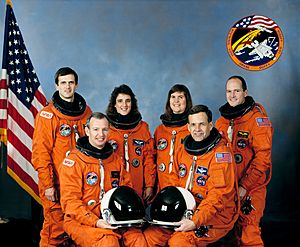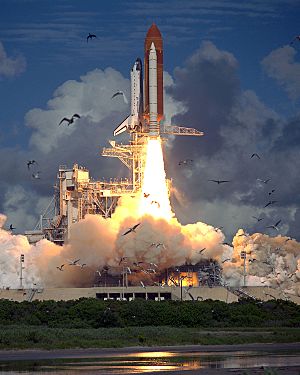STS-57 facts for kids
STS-57 was an important NASA Space Shuttle mission. It launched on June 21, 1993, from the Kennedy Space Center in Florida. The mission used the Space Shuttle Endeavour and carried a special module called Spacehab. This flight was all about doing science experiments in space and bringing back a satellite.

|
|
| Names | Space Transportation System-56 |
|---|---|
| Mission type | Biosciences EURECA satellite retrieval |
| Operator | NASA |
| Mission duration | 9 days, 23 hours, 44 minutes, 54 seconds (achieved) |
| Distance travelled | 6,608,628 km (4,106,411 mi) |
| Orbits completed | 155 |
| Spacecraft properties | |
| Spacecraft | Space Shuttle Endeavour |
| Landing mass | 101,657 kg (224,115 lb) |
| Payload mass | 13,074 kg (28,823 lb) |
| Crew | |
| Crew size | 6 |
| Members |
|
| Start of mission | |
| Launch date | 21 June 1993, 13:07 UTC |
| Rocket | Space Shuttle Endeavour |
| Launch site | Kennedy Space Center, LC-39B |
| Contractor | Rockwell International |
| End of mission | |
| Landing date | 1 July 1993, 12:52 UTC |
| Landing site | Kennedy Space Center, SLF Runway 33 |
| Orbital parameters | |
| Reference system | Geocentric orbit |
| Regime | Low Earth orbit |
| Perigee | 402 km (250 mi) |
| Apogee | 471 km (293 mi) |
| Inclination | 28.45° |
| Period | 93.30 minutes |
 STS-57 mission patch  Back row: Peter J. Wisoff, Nancy J. Currie-Gregg, Janice E. Voss, G. David Low Front row: Brian Duffy, Ronald J. Grabe |
|
Contents
Meet the Astronauts
Six astronauts flew on the STS-57 mission. They worked together to complete all the tasks in space.
| Position | Astronaut | |
|---|---|---|
| Commander | Ronald J. Grabe Fourth and last spaceflight |
|
| Pilot | Brian Duffy Second spaceflight |
|
| Mission Specialist 1 | G. David Low Third and last spaceflight |
|
| Mission Specialist 2 | Nancy J. Currie-Gregg First spaceflight |
|
| Mission Specialist 3 | Peter J. Wisoff First spaceflight |
|
| Mission Specialist 4 | Janice E. Voss First spaceflight |
|
Spacewalk Adventure
Astronauts David Low and Peter Wisoff went on a spacewalk during the mission. This was their only spacewalk for STS-57. It started and ended on June 25, 1993. The spacewalk lasted for 5 hours and 50 minutes.
Mission Highlights
The STS-57 mission lasted for ten days. The astronauts did many science experiments. These experiments were about biology and materials science. They took place inside the special Spacehab module.
A big part of the mission was to get back the European Retrievable Carrier (EURECA) satellite. This satellite had been in space since August 1992. It was launched by the Space Shuttle Atlantis. EURECA carried experiments to study how long-term microgravity (weightlessness) affects things.
Fixing EURECA
There was a small problem with EURECA. An electrical connector on Endeavour's robotic arm was not put in correctly. This meant EURECA could not charge its batteries using the shuttle's power. Astronauts David Low and Peter Wisoff had to fix this during their spacewalk.
David Low was on a foot restraint at the end of the robotic arm. Astronaut Nancy J. Currie-Gregg controlled the arm. Low gently pushed EURECA's antennas into place. Ground controllers then locked the antennas. This spacewalk fixed the problem and secured EURECA. It was the main goal of the STS-57 mission.
After fixing EURECA, Low and Wisoff did more tests. They practiced moving heavy objects with the robotic arm. Both astronauts took turns on the arm. They finished their spacewalk and went back inside the shuttle.
Science in Space
The crew spent the rest of the mission on experiments. These were done in the Spacehab module. They studied how the human body changes in space. They also looked at how crystals grow in microgravity. Other experiments involved metal alloys and recycling wastewater.
One experiment tested equipment for a future space station. Nancy J. Currie-Gregg used electronic tools. She tested a fake circuit board. She sent messages to the ground about how to fix it.
On June 22, 1993, all six astronauts talked with President Clinton.
Brian Duffy and Peter Wisoff also did an experiment called FARE. This stands for Fluid Acquisition and Resupply Experiment. They studied how to move liquids in space without making bubbles. This helps engineers learn how to refuel spacecraft in orbit. They moved water between clear tanks. They watched how the water behaved when the shuttle's small steering jets fired.
Janice Voss worked on the LEMZ experiment. This used a process called floating zone crystal growth. Growing crystals in space helps them become larger and purer.
Body Changes in Space
Ronald Grabe, Brian Duffy, and Janice Voss took part in a study. It was about how the body's posture changes in space. Astronauts often get a "zero-g crouch" in weightlessness. Their spines also get longer by about 26 to 51 millimeters.
Researchers took photos and videos of the crew. They did this at the start and end of the mission. This helped them understand these body changes better. This information is used to design future spacecraft. It makes sure work areas are comfortable for astronauts.
Nancy J. Currie-Gregg also worked on human factors. She set up a work platform. Then she used a laptop to practice a procedure for a space station's propulsion system.
On June 28, 1993, Currie-Gregg fixed a plumbing issue. It was for an experiment on wastewater purification. This experiment used a special liquid to act like wastewater. It was pumped through filters to clean it. When the flow slowed down, Currie-Gregg fixed a loose fitting. She also reversed a pump to clear a clog. This showed how astronauts can do repairs in space.
Mission Patch
The STS-57 mission patch has special symbols. The five stars and the shape of the robotic arm show the mission's number. The red line inside the patch represents the Spacehab module. You can also see the EURECA satellite with three yellow trails. These trails look like the traditional astronaut insignia. The orbiter is shown circling Earth.



